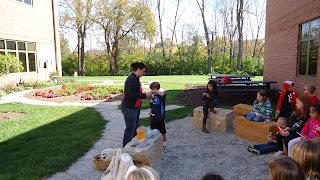The second graders helped test the soil at the butterfly garden. We had tons of fun. Here's what we learned:
Red cabbage contains a pigment called flavin. It dissolves in water and is also found in apple skin, plums, poppies, cornflowers and grapes. If what you're testing is very acidic, it will turn a red cabbage solution a red color. Neutral solutions result in a purplish color. Basic (alkaline) solutions appear in greenish-yellow.
To make the
red cabbage solution I chopped one large red cabbage and boiled it until the
water turned a purple color.
Strain out
the cabbage to obtain a red-purple-bluish colored liquid. The liquid is at a pH7.
I soaked
coffee filters in the solution for about fifteen minutes then let them dry outside.
I cut the coffee filters into long strips.
We used these to test the soil.
There were five classes of second graders so classes took turns coming to the garden. Each class stayed for thirty minutes
learning about soil and how to test.
We did a few
experiments that showed what happens when the soil contains acid or when it is
alkaline. I poured a little of the
solution out into a small container.
Then added white vinegar to one glass, drop by drop. I mixed a teaspoon of baking soda into
another container. The kids were able to
see different colors depending on the amount of each ingredient. We ended up with bright blue, shocking pink,
and purple. This works great because red
cabbage water reacts with either acids like vinegar and base (alkaline)
substances, like baking soda and changes color.
Acids tend to be turn the strips pink, and bases turn it blue or green.









.JPG)
.JPG)
.JPG)
.JPG)
No comments:
Post a Comment